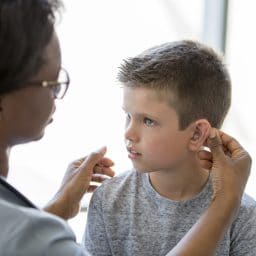Can Hearing Aids Help Kids Learn?

Research shows that, left untreated, hearing loss can impact a child’s language development and school performance. Fortunately, studies have also shown that hearing aids and other treatment options can minimize this impact and help children learn better. What the Studies Show The University of Iowa conducted a study published in 2015 showing that children with…
How to Talk to a Loved One About Hearing Loss

If your loved one has hearing loss, it may be bothersome when they turn up the TV louder than is comfortable to you, avoid participating in social events and ask you to repeat yourself often. But the risks of hearing loss are far worse than mere inconvenience; untreated hearing loss is linked to accidents requiring…
Strategies for Hearing Better in Everyday Situations

Georgia has been among the first states reopen businesses after lockdowns due to safety concerns raised by the Coronavirus. As you transition back into public spaces, here are some tips for better hearing and listening. At Work Hearing in work environments can be challenging. Background noise from nearby meetings, phone calls and water cooler conversations,…
How to Read an Audiogram

What is an audiogram? In short, it is a useful tool that audiologists use to help people understand their hearing loss by providing a graph or chart that displays the results of their hearing test. Audiograms show your hearing threshold, which is the quietest sound you can hear at least half the time, across various…
Can Exercise Harm Your Hearing?

While regular exercise has a myriad of benefits, that doesn’t mean there aren’t risks as well. In fact, it may surprise you to learn that certain forms of exercise can negatively impact your hearing. Heavy exertion and the noise levels in gyms can both have an effect on your hearing health. The Link Between Weightlifting…
Face Masks Pose Problem for the Hearing Impaired

The CDC is recommending that people wear face masks in public places to prevent the spread of COVID-19. While this is an important measure to protect people from the virus, it does pose a problem for people with hearing loss. This is both because the mask makes communication difficult by muffling speech and creating a…
How to Prevent Hearing Damage from Headphones

Many people love listening to their favorite music, podcasts or radio stations on the go. Everywhere you look, you’ll see people listening to something through their headphones or earbuds, especially now that wireless options are available. This luxury, however, can be costly. According to the World Health Organization, 1.1 billion young people worldwide are putting…
Understanding Childhood Ear Infections

Ear infections are usually caused by bacteria that grows when there is a buildup of fluid behind the eardrum. While anyone of any age can get an ear infection, they are most common in children. In fact, five out of six children will have at least one ear infection by their third birthday. Ear infections…
What Is Low-Frequency Hearing Loss?

Low-frequency hearing loss is one of the rarer forms of hearing loss, and is also known as “reverse-slope hearing loss” because of the shape it makes on an audiogram – a chart used by audiologists to measure hearing loss. Symptoms of Low-Frequency Hearing Loss Low-frequency hearing loss means difficulty hearing low-pitch sounds. People with this…
Hearing Hazards in the Home
Noise induced hearing loss (NIHL) can be caused by one-time exposure to an extremely loud sound, like an explosion, or prolonged exposure to moderate noise. OSHA reports that any sound over 85 dB – about the volume of highway traffic – can cause permanent hearing damage after just 15 minutes of exposure. The National Institutes…